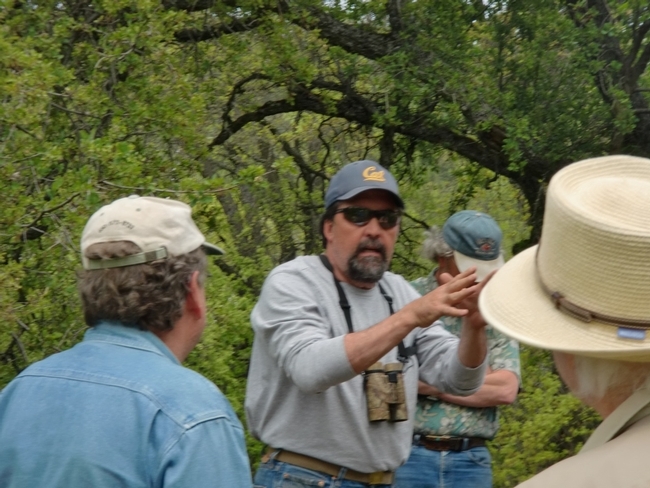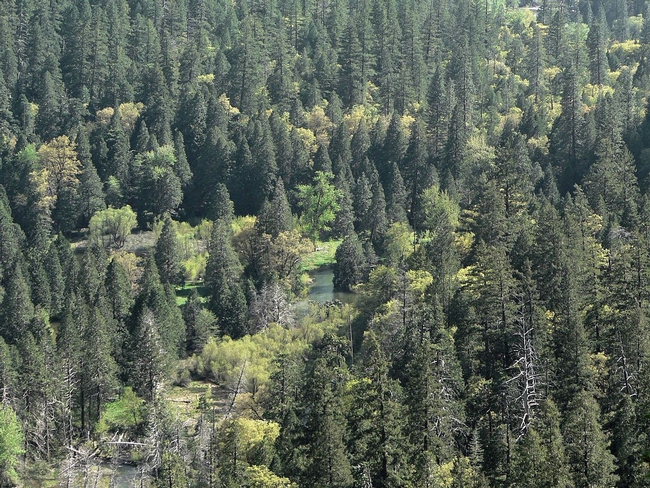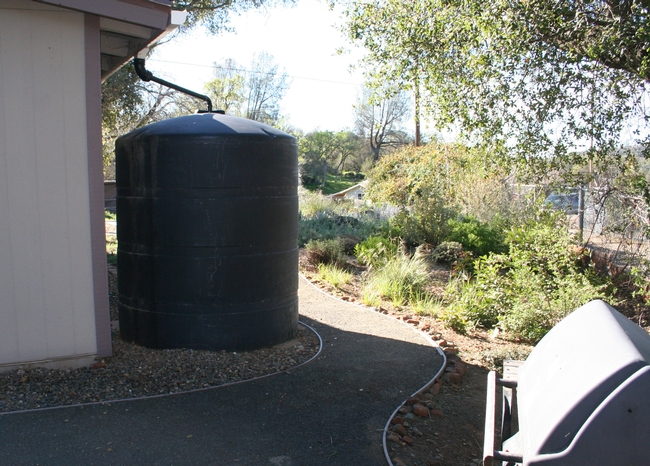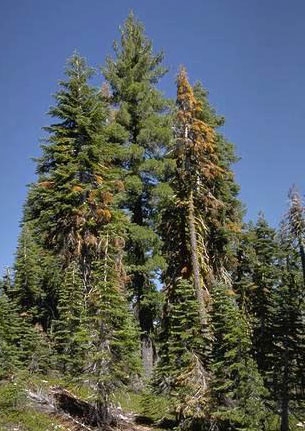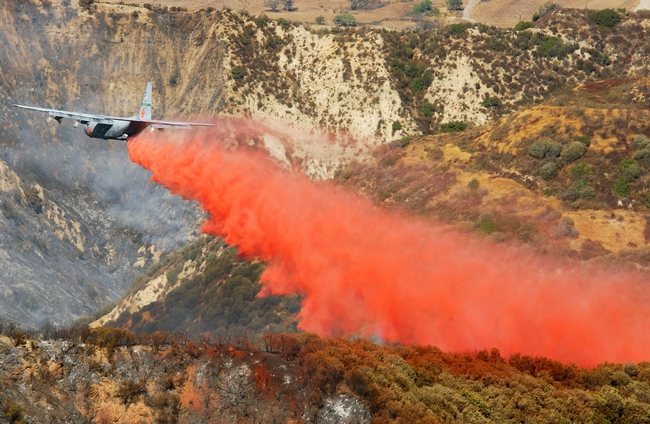Posts Tagged: wildfire
Rocky Fire is raging through bone dry chaparral shrublands
Northern California's Rocky Fire is roaring through shrublands that have no previous recorded history of wildfires, reported Kirk Siegler on All Things Considered. It has already burned 65,000 acres and is 12 percent contained, according to CalFire's Incident Report.
The area has been protected from fire for decades, primed for the type of catastrophic blaze California officials have been predicting.
Siegler spoke to UC Agriculture and Natural Resources Cooperative Extension wildland and forestry advisor Greg Giusti.
"We've got miles and miles of contiguous chaparral vegetation and literally there are no breaks in the vegetation," Giusti said. "It's extremely steep and, in many cases, it's a roadless area."
Four years of drought has left the vegetation bone dry.
'When these fires get to an intensity we've seen, because of the fuel loading, because of fire suppression for the last 50 or 60 years, it allows the plant communities to get so dense, so thick and so expansive that, once a fire starts, it's beyond the capabilities of human control," Guisti said.
More forest research needed to understand best management strategies
UC Agriculture and Natural Resources (UC ANR) forestry expert Bill Stewart joined U.S. Representatives Bruce Westerman (R-Arkansas) and Tom McClintock (R-California), and an environmentalist in a one-hour discussion about the Resilient Federal Forests Act of 2015 with Michael Krasny on KQED Forum. The act was recently passed by the House and is now awaiting action by the Senate.
During the program, Stewart said there is a need for more research to study different approaches to forestry management.
“Chad (Hanson, the environmentalist) and the representative (McClintock) feel they figured it all out, but there are some big questions worth exploring,” Stewart said.
Hanson is the director of the John Muir Project of Earth Island Institute.
At the beginning of the discussion, Westerman and Hanson outlined their visions of proper management of federal forests. Westerman said the bill would make forests more healthy and sustainable.
"We're going to have fire," he said. "In California, a lot of resources are being spent on fire suppression. With the Resilient Forests Act we are creating more fire prevention, scientifically. Salvage logging is a part of that. Also, thinning and reducing fuel load."
Hanson said Westerman's points were untrue. He said current efforts to suppress fires and post-fire logging lead to more intense fire in the future and damage wildlife habitat.
Stewart said salvage logging need not be a yes-or-no question.
"It depends how you design that," he said. "Snags (standing dead trees) are important. Do we leave 500 snags per acre, 50, 5 or zero. We can try all four approaches and see."
Stewart pointed out that the Resilient Forestry Act, if passed, would require environmental assessment of active forest management vs. following a hands-off policy.
Firescaping can protect homes during wildfire season
Landscape + fire-prone area x protect = firescaping. The newly coined word offers hope to people who love living in wildland areas but fear a wildfire could wipe out their homes and belongings, reported Suzanne Sproul in the Inland Valley Daily Bulletin. The article also appeared in the Long Beach Press Telegram, the Daily Breeze and the LA Daily News.
UC Agriculture and Natural Resources (UC ANR) experts says its impossible to eliminate the risk, but firescaping can lessen the danger.
"I know people want to avoid moonscapes in their yards, but there are plenty of choices out there," said UC ANR Cooperative Extension specialist Tom Scott.
The article suggests homeowners
- Trim overgrown plants
- Replace highly flammable plants and trees - such as eucalyptus and palms - with less flammable plants - such as ocotillo and Calla lilies
- Use creative hardscapes, such as non-combustible fencing and inorganic mulches
The article included a link to UC ANR Cooperative Extension's information on fire safe landscaping.
Trees dying due to drought are prone to wildfire
Across California, pine trees that have been weakened by the drought are having trouble defending themselves from bark beetles, causing widespread tree death. The dead trees won't cause fires, but when ignited they will be hotter and be more difficult to control, according to articles that ran over the weekend in the Santa Rosa Press-Democrat and the Desert Sun.
“Statewide, it's horrific,” said Greg Giusti, UC ANR Cooperative Extension advisor.
Max Moritz, UC ANR Cooperative Extension specialist in fire ecology, described the combination of exceptionally low vegetation moisture and widespread plant deaths as "a double-barreled threat."
"On top of the dry conditions, it's been unusually hot in many, many parts of the state," Moritz said. "We do have a pretty exceptional fire season stacking up, or the potential for one."
The Los Angeles Times also covered the story earlier this month.
Scott Stephens, fire science professor at UC Berkeley, said fire suppression and harvesting have made forests more dense over the last 100 years. The increased density has made trees more vulnerable as they compete for limited amounts of water, with the weaker trees more susceptible to bark beetle infestations, he said.
“If the drought continues for another two years or longer, I expect this mortality to move throughout the state,” Stephens said. “Forests that once burned frequently with low-moderate intensity fire regimes are the most susceptible.”
Attacking fire from the air is costly
Dropping fire retardant from airplanes onto roaring wildfires is expensive, dangerous and may have minimal impact, reported Kevin Oliver in an aerial-minute TV news piece investigating aerial fire fighting for KCRA-TV in Sacramento.
The aerial attack on the 2013 Rim Fire near Lake Tahoe cost $11 million, a substantial portion of the $95 million effort to put out the blaze, the story said.
"It's a huge cost," said Bill Stewart, UC Agriculture and Natural Resources fire science researcher and former state firefighter. "It can go up as high as you want and keep on sending aircraft."
Stewart, who serves as a UC ANR Cooperative Extension specialist in the Center for Forestry at UC Berkeley, questions whether air drops are used more than they should be.
"When the fires are really hot, sometimes they are not effective. The flames are going up so the (water and retardant) never gets on the fires," Stewart said.
Air attacks are often referred to within the ranks as "CNN drops," Stewart said, because they look good on TV, and the general public expects them.
"It helps some, and if you didn't do it, people would say, 'Why didn't you call it in?'" Stewart said.
He believes the money used for air attacks could often be better spent on hand crews and bulldozers.
"I always asked, 'What's the cost-effectiveness of these drops?' and they said, no one has ever tried to look at it," Stewart said.


